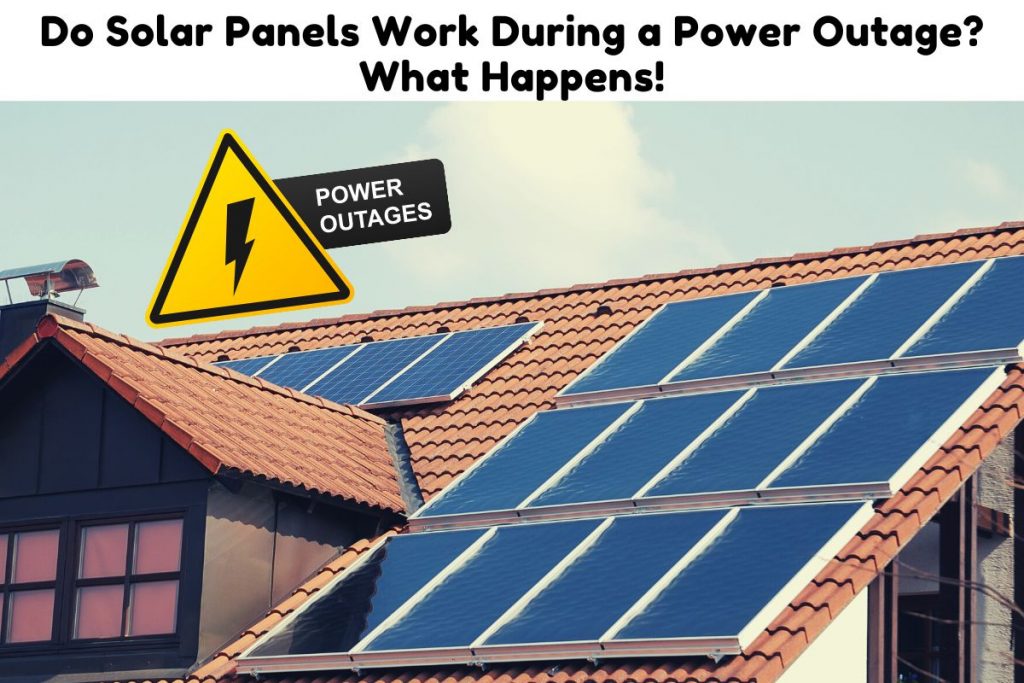The U.S has more power outages than any developed nation. Incredible as that may sound, a recent study by the Galvin Electricity Initiative revealed that U.S consumers spend more time in the dark than any other industrial country.
Time spent without electricity is likely to get longer and more frequent due to outdated infrastructure and extreme weather patterns. What are your alternatives if you don’t want to be stuck in the dark for hours on end?
Can you use solar panels in a blackout? The quick answer to this question is yes. The long answer is it depends on what type of solar system you have. If you want to know how solar panels work in a blackout and what type of solar system you need to have then you are in the right place.

Why Don’t Solar Panels Work in A Blackout?
Solar systems have a function that prevents them from feeding electricity back into the grid in a blackout. This is a safety precaution to prevent any accidental harm to utility workers that might be working on your power lines when the power goes out.
On a side note! If you’re in need of a reliable and high-performance portable solar panel, We strongly recommend the Jackery SolarSaga 100W Portable Solar Panel (Amazon Link).
With a high conversion efficiency and foldable design, this solar panel is easy to transport and set up, making it perfect for outdoor activities like camping, hiking, and RV trips.

The US solar cell technology used in this panel ensures that you get the most efficient and reliable solar charging possible.
There is also a 60W option that is more affordable (Amazon Link)
In the U.S blackouts are typically caused by the weather, high peak demand, and wear and tear on the grid. Ohio and Indiana are the states hardest hit by power outages. (Source)
| STATE | OUTAGES (CUSTOMERS WITHOUT POWER) |
| Ohio | 357,119 |
| Indiana | 72,851 |
| West Virginia | 61,078 |
| Illinois | 58,975 |
| Michigan | 46,216 |
There are three different types of solar systems. These are grid-tied, off-grid, and hybrid. Only two of these will provide you with electricity in a blackout.
Grid-tied systems
Grid-tied systems are the most commonly used type of solar system. In a grid-tied system, your solar is connected to the power utility. The main advantage of this system is you get both solar and grid-supplied electricity. Grid-tied systems are the cheapest type of solar system.
The drawback of this system is it does not work during a power outage. Grid-tied systems have a shutdown feature that stops them from feeding current into the grid when the power is out. This is called “anti-islanding” and it is an inbuilt safety feature of grid-tied inverters.
Off-grid systems
An off-grid system is not connected to the grid. All your electricity needs are met by the solar system or the solar system and an alternative energy source like a generator or wind power. All off-grid systems have solar energy storage in the form of a battery.
Off-grid systems are the most expensive type of solar system. This is because you need more batteries to compensate for the absence of grid-supplied electricity. With an off-grid system, a power outage is not an issue since the system is not connected to the grid.
Hybrid systems
A hybrid system is a combination of a grid-tied and off-grid system. These are systems that are connected to the grid but also have batteries. A hybrid system can still provide you with electricity because it uses a hybrid inverter.
A hybrid inverter does not have the anti-islanding feature of a grid-tied inverter. Instead, a hybrid inverter uses what is known as “islanding”. Here the inverter will isolate your system by disconnecting from the grid in an outage.
This allows you to have electricity but does not feed electricity into the grid which could potentially be a safety hazard if any line workers are carrying out repairs or maintenance.
What Happens to Solar Panels when The Power Goes Out?
Solar panels will still produce energy when the power goes out. However, your solar energy system may shut down depending on whether it is a grid-tied or hybrid system. A grid-tied system will not provide you with electricity when the power goes out. A hybrid system on the other hand will.
A hybrid system is the best way to keep the lights on in a blackout. With a hybrid system, you get the benefits of both a grid and off-grid system but without the downsides of either. It’s cheaper than off-grid and you still have electricity in a blackout thanks to the battery backup. (Source)
Another way to use solar in a blackout is to power a generator. Solar-powered generators are a cheaper alternative to hybrid solar systems.
They’re also a cleaner alternative to gas-powered generators. Solar generators have:
- Solar panels that generate energy.
- A charge controller controls the voltage going into the batteries.
- Batteries store energy from the solar panels.
- An inverter that converts DC energy in your battery to AC energy your appliances use.
Solar generators are preferable to gas-powered generators because they do not make any noise and do not require gas to run. The downside to solar generators is they supply a limited amount of power and they have a higher upfront cost compared to gas generators. (Source)
How Long Will a Solar Battery Last During a Power Outage?
How long a battery lasts in a power outage depends on its capacity and the load on the battery. A 10kWh battery can last between 10 to 12 hours with a load of 750 to 1000 watts.
Battery capacity
Batteries come in different capacities. The capacity is a measure of how much energy the battery stores. However, you can’t completely drain a battery of all its energy. Not if you want to avoid damaging the battery.
This is why batteries have a depth of discharge. The depth of discharge in a battery is how much energy you can draw from it without damaging the battery. Using a battery past its depth of discharge permanently reduces the battery’s capacity over time.
Lithium batteries have a better depth of discharge compared to other batteries used in solar applications. You can safely use up to 80% of a lithium battery’s stored energy. Lead-acid batteries have a smaller depth of discharge allowing you only 50% of energy before you need to recharge them. (Source)
Load
Load is how many appliances are drawing energy from your batteries. The higher the load the more energy you are drawing out. The more energy you are drawing out the quicker the battery gets drained.
